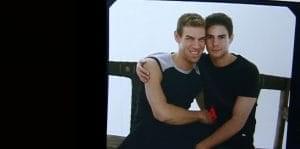
One of the enduring elements of the American narrative is that — given enough drive, hard work, passion, and talent — anyone can scale any height, no matter how high, and accomplish great things. In truth, for those of modest/little means, this is more often not a far-flung fantasy. Every once in a great while, however, someone comes along who rises above extraordinary circumstances to achieve greatness. In the 1980s, Kevyn Aucoin — a shy, gay kid from Shreveport, Louisiana — moved to New York City where he soon rose to international prominence as a makeup artist who would define and then transcend the form. Weaving together first-person testimonials of a who’s who of late 20th Century fashion models and designers, Tiffany Bartok’s engrossing documentary, Larger Than Life: The Kevyn Aucoin Story, charts Aucoin’s journey — with all of its dramatic highs and terrible lows — from his bedroom in Louisiana to the catwalks of Paris.
With his collection of Barbara Streisand albums and posters and penchant for things labeled feminine, Kevyn Aucoin was an outlier in the Shreveport of his youth in the 1970s. Picked upon brutally at school, Aucoin found refuge/escape in making up his sister and female friend while dreaming about escaping his confines. “I was determined to be myself regardless of the consequences,” Aucoin recounts in the film. After another professional makeup artist gifts him the seminal make-up artist manual “Designing Your Face” by Way Bandy, Aucoin headed to the New York with a determination to make a name for himself in the field. As humorously recounted by a former Vogue editor, Aucoin — portfolio in hand — planted himself in Vogue’s office and, through sheer force of will and bit of luck, landed a gig doing the makeup on a photo shoot of a young Meg Tilly. For those old enough to remember, the 1980s was a time typified by loud fashion patterns, big hair, and (some would say) garish makeup choices. In a move that would define his professional life, Aucoin went against the prevailing trends and instead chose a natural style but with a bit of a twist for his first high profile job. His work was immediately noticed for its beauty, boldness, and uniqueness. From there, he was off and running, soon landing a cover for Vogue magazine and the makeup slot for the coveted Geoffrey Bean fashion show.

“…rose to international prominence as a makeup artist who would define and then transcend the form.”
Director Bartok makes an important distinction that, before Aucoin, make-up artistry wasn’t really a “thing.” Models often did their own faces and those makeup artists who were employed in the fashion industry, their skills were totally ancillary to the whims of the fashion designer and photographer.
More like a painter than a makeup artist, Aucoin upended these norms. So fierce and revolutionary was his talent, that he became as much (if not more) of a star than the models and designers that he worked with. Supermodels — from Naomi Campbell to Cindy Crawford (who humorously recounts the time Aucoin plucked her famous eyebrows pencil thin, causing a virtual riot in hi-fashion circles) — and designers like Isaac Mizrahi testify to his talent in the film. He published three books (including the New York Times best seller, “Making Faces”), established his own makeup line, and was the first make-up artist to win a Council of Fashion Designers of America award. Soon, Aucoin transcended beyond the fashion world and found himself in the vaunted world of celebrity, making up the faces of Liza Minnelli, Cher (with whom he would go on to forge a strong friendship), RuPaul, and — ultimately — his childhood heroine, Barbara Streisand.
However, the same qualities that made Aucoin such a success, were also his Achilles’ heel. A demanding perfectionist, Aucoin could also be quick and cutting. His make-up sessions sometime lasted hours, crowding out time allotted to other stylists and even the photographers. Interviews with Aucoin’s past lovers and husband speak to the complexity of his character. “He had a mission: to right a wrong from his childhood,” notes one partner. He was also in constant physical pain, seemingly the result of acromegaly — a disorder caused by excess production of growth hormone — that was diagnosed late in his life. By that time, Aucoin was overusing several drugs to deal with his physical and, the filmmaker suggests, emotional pain.

“…probes issues of creativity, sexual identity, and celebrity culture.”
When the inevitable happens and Aucoin passes away at the tragically young age of 40 in 2002, it is not a surprise but still shocking. Singer/songwriter Tori Amos insightfully remarks that “He didn’t want to let-us down.” Models and celebrities “were addicted to him and he was addicted to making us beautiful.”
Larger Than Life: The Kevyn Aucoin Story is a well constructed, warts-and-all documentary that probes issues of creativity, sexual identity, and celebrity culture. A talent like Aucoin’s was a rare thing indeed. “The most extraordinary experience I can have is to show someone their beauty and then help them find beauty in (themselves),” notes Aucoin at the film’s outset. The fact that he often had trouble recognizing his own inner beauty — despite his numerous accolades and awards — endows the film with a resonance that is sad, profound, and universally human.

Larger Than Life: The Kevyn Aucoin Story (2017) Directed by Tiffany Bartok. Featuring Kevyn Aucoin, Issa Mizrahi, Christy Turlington, Tori Amos, Cindy Crawford, Paulina Porizkiva, Naomi Campbell, and Todd Oldham.
8 out of 10 stars
